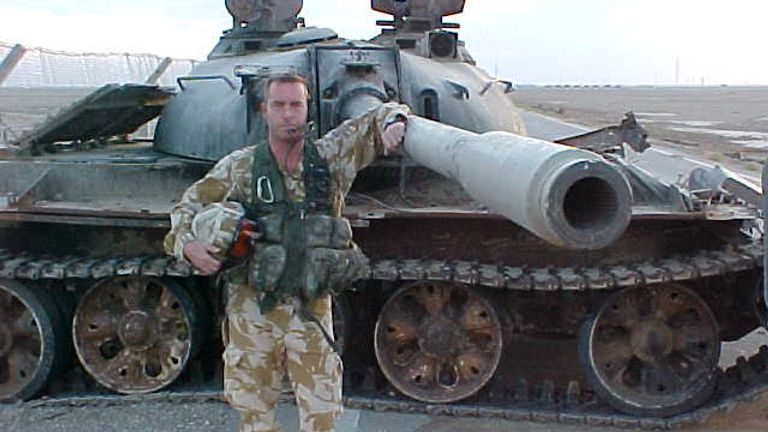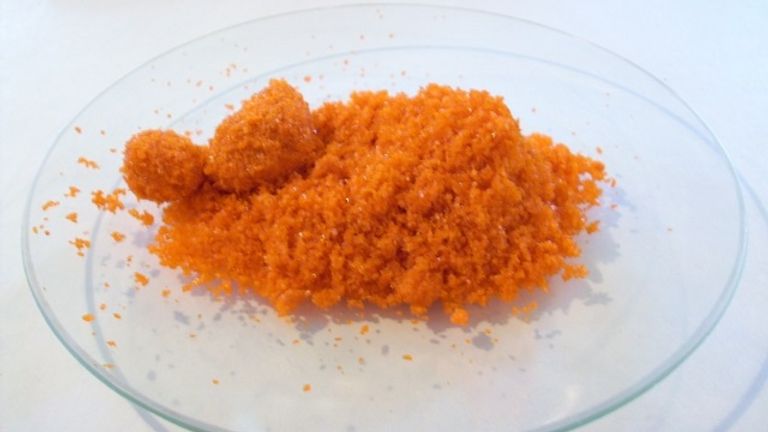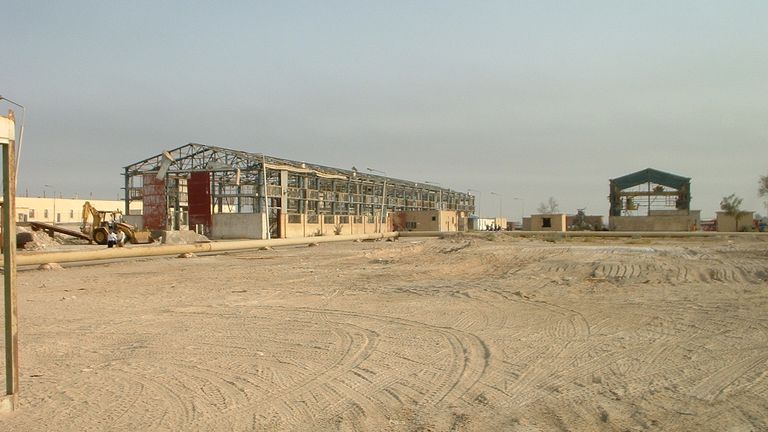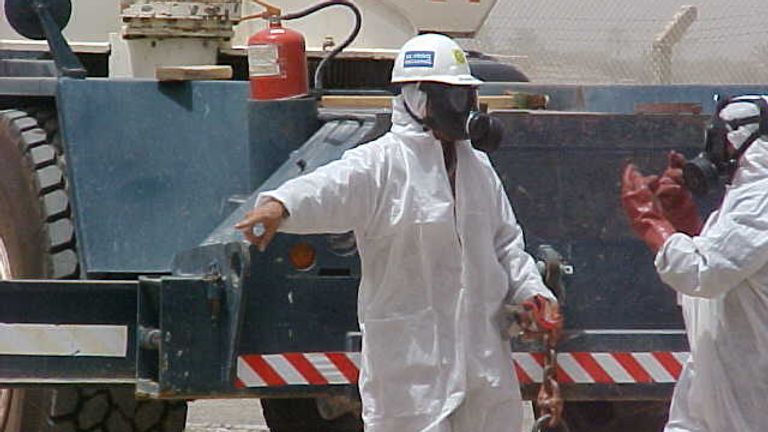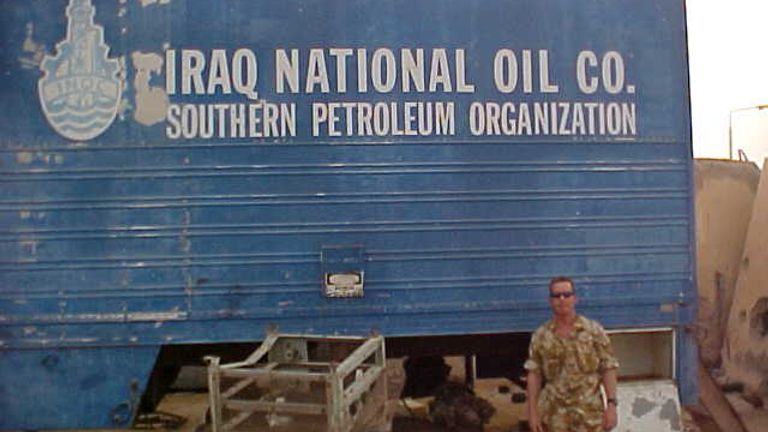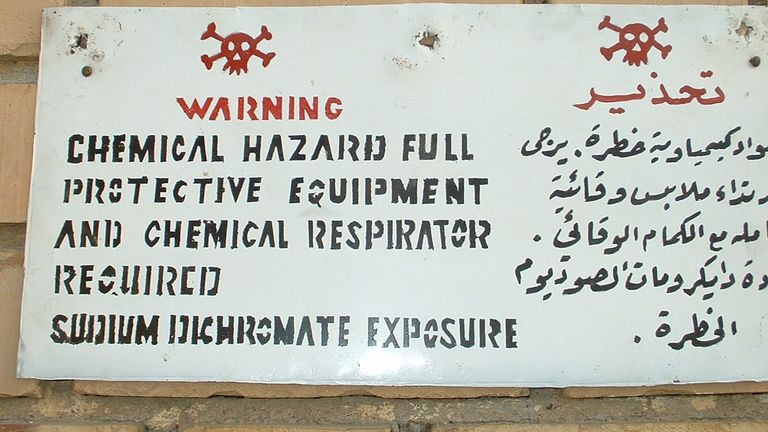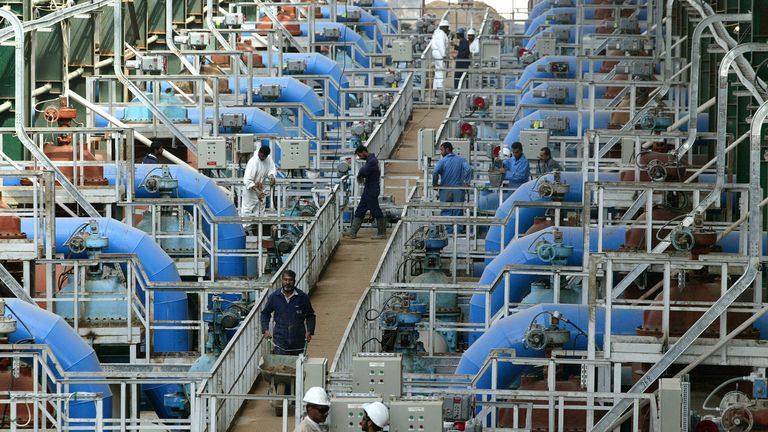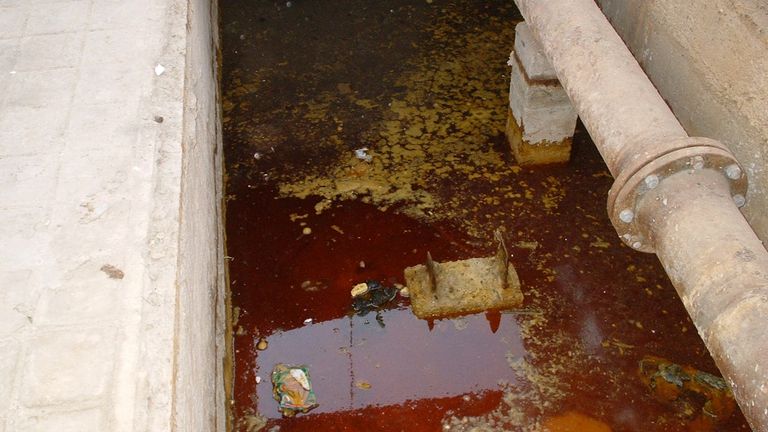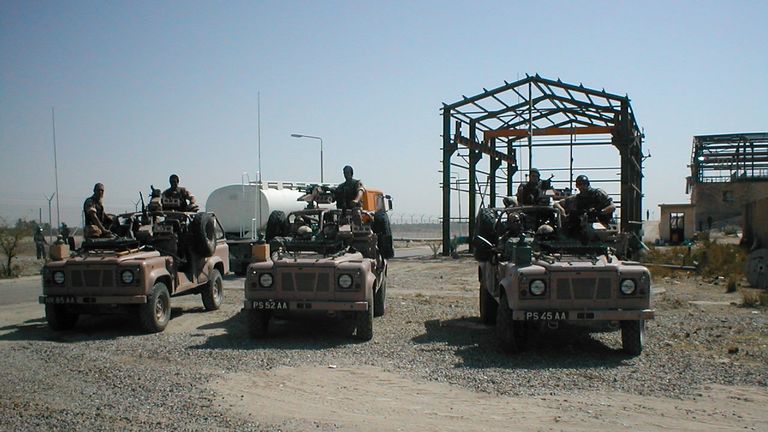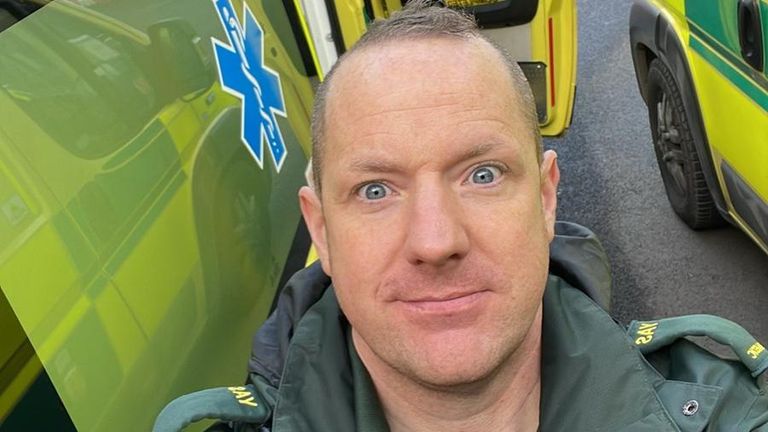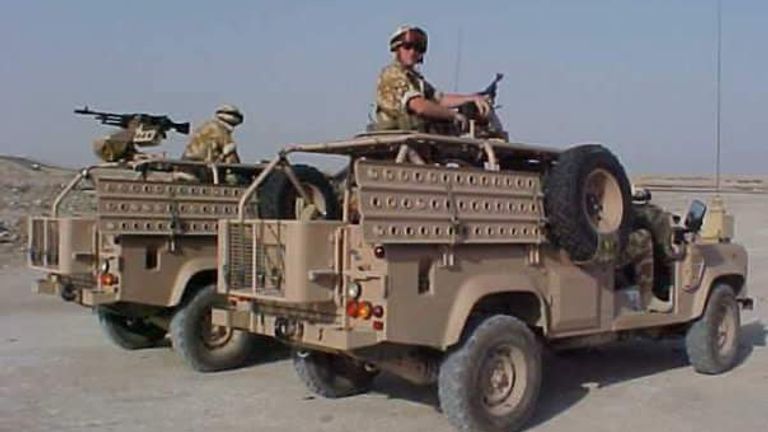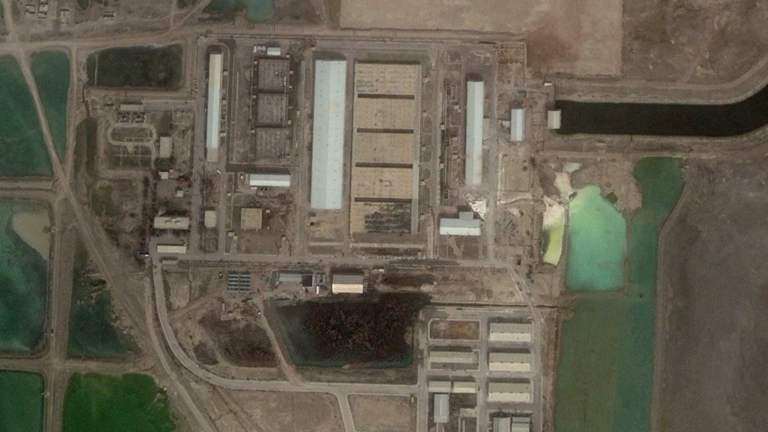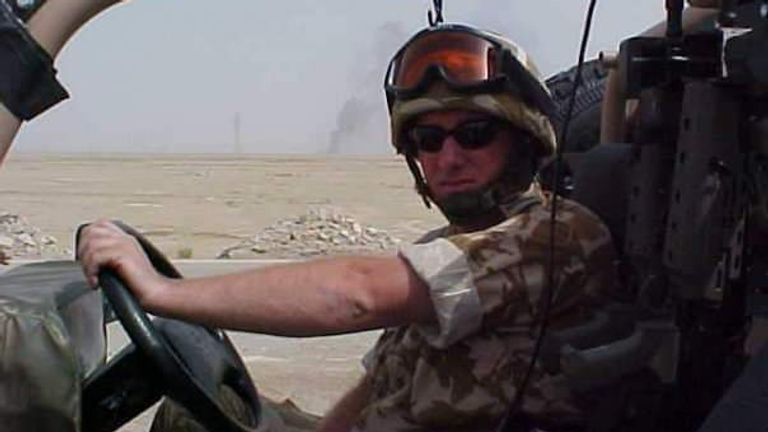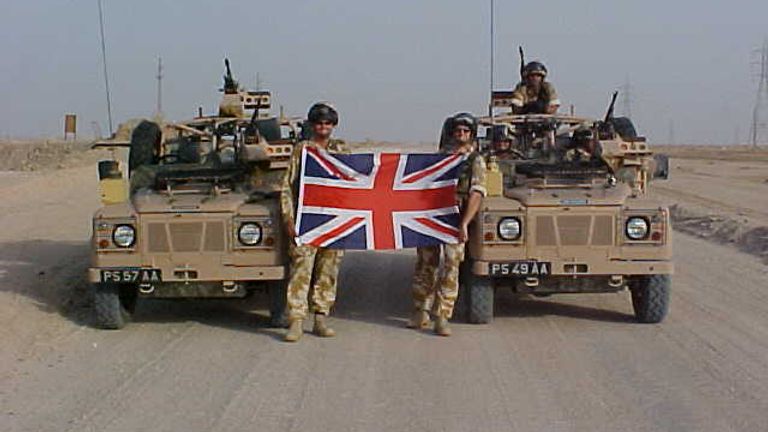Iraq war veteran Andy Tosh points to his nose where he was treated for skin cancer and shows the red marks on his hand.
His health has been permanently damaged – not by the baking heat of the Iraqi desert, he says, but by a toxic chemical at the industrial site he was ordered to guard.
“It’s clear British troops were knowingly exposed,” the 58-year-old former RAF sergeant says.
Sky News can reveal that nearly 100 British troops may have been exposed to sodium dichromate while guarding the Qarmat Ali water treatment plant in 2003.
Ten British veterans who guarded the plant have now spoken publicly about their ordeal – and say they feel “betrayed” by the UK government after struggling with a range of health problems, including daily nosebleeds, a brain tumour and three who have been diagnosed with cancer.
Described as a “deadly poison”, sodium dichromate is a known carcinogen. The ground at Qarmat Ali was covered in it, according to the former servicemen.
The Ministry of Defence says it is willing to meet the veterans to work with them going forward – but the former troops say they want answers and accountability.
‘It was like a scrapyard’
In the opening months of the Iraq war, around 88 British troops were deployed to Qarmat Ali, providing an armed guard detail round the clock.
Located near Basra, Qarmat Ali was built in the 1970s to pump water through a network of pipes in order to flush out oil nearby.
Wearing heavy combat gear, British soldiers endured baking 50C heat in the day and listened to rocket fire from insurgents at night as they patrolled the industrial facility.
What they didn’t know was that the place was contaminated with sodium dichromate, a chemical used to prevent corrosion.
Before the US took over the site, the water was filtered and treated with sodium dichromate to increase the life of pipelines, pumps, and other equipment.
It’s a type of hexavalent chromium, a group of compounds made famous by the 2000 film Erin Brockovich, which dramatised the contamination of water around a California town.
Members of the military described how thousands of bags of the orange powder were kept in a building with no roof, some of them ripped open, exposing their contents to the wind. Others were spread throughout the facility.
So why were British soldiers there at all?
Qarmat Ali was considered critical to getting Iraq’s oil production up and running after Saddam Hussein was defeated, and the US government appointed contractors KBR to run the site.
US soldiers would escort a convoy of KBR workers to Qarmat Ali on day trips, where they worked under the protection of British RAF troops.
“It was like a scrapyard,” says Jim Garth, a former corporal who was deployed to Iraq after serving in Northern Ireland.
Amid the chaos of the invasion, much of the site had been looted for metal. Leaking chlorine gas canisters lay on the ground.
But what could not be explained were the nosebleeds, rashes and lesions suffered by UK troops stationed there, say the former servicemen, and among the US soldiers who visited the site.
“I noticed a rash on my forearms,” Mr Tosh said. “I’d operated in other hot tropical countries, I’ve never had a rash like I had on my forearms.
“Other members of our teams had different symptoms but at the time we had no idea why.”
It was a mystery.
That is, until two workers in hazmat suits and respirator masks turned up in August 2003 and put up a sign with a skull and crossbones on it.
“Warning. Chemical hazard. Full protective equipment and chemical respirator required. Sodium dichromate exposure” the sign read.
“We were shocked,” Mr Tosh added. “We’d already been on that site for months, being exposed.
“It was a different type of threat that none of us could really understand.”
And the yellowy orange powder wasn’t just on the ground, it was blown around in the wind, Mr Garth says.
“So unbeknownst to us it was all around us all the time,” he added.
An investigation by the US defence department found service members and civilians were “unintentionally exposed” to toxic chemicals.
The report also pointed blame at KBR for a delay in recognising and responding to the hazard posed by sodium dichromate.
It said KBR became aware of the use of sodium dichromate at Qarmat Ali as early as 31 May 2003, when the company reviewed an Iraqi operating manual describing the use of the chemical at the facility.
According to the report, both KBR and Task Force Restore Iraqi Oil, the military group responsible for restoring Iraqi oil production, reported in June 2003 that the site was potentially contaminated with sodium dichromate, which they recognised as a carcinogen.
US commander’s death linked to sodium dichromate
The plight of US troops who were exposed to sodium dichromate at Qarmat Ali is far better documented than their UK counterparts.
National guardsmen who visited the site have become ill, leading to a formal inquiry and government support for veterans across the pond.
“While I was at Qarmat Ali, I began suffering from severe nosebleeds,” Russell Powell, an American former medic, told a Senate inquiry.
Within three days of arriving at the plant in April 2003 he developed rashes on his knuckles, hands and forearms, he said.
Others in his platoon suffered similar ailments, he added.
Mr Powell said he had questioned a KBR worker about the powder, who said his supervisors had told him not to worry about it.
Speaking at a hearing in 2009 held as part of the inquiry, Mr Powell added: “My symptoms have not changed since my service in Iraq… I cannot take a full breath.”
Lieutenant-Colonel James Gentry, of the Indiana National Guard, was stationed at Qarmat Ali in 2003.
“They had this information and didn’t share it,” he said in a deposition video, his face pale as he struggled to breathe. He was referring to contractors KBR.
“I’m dying now because of it.”
Lt Col Gentry died from cancer in 2009. The US Army deemed that his death was “in line of duty for exposure to sodium dichromate”, according to court documents.
Read more:
UK ‘must’ increase defence spending ‘now’, minister warns
Iraqi president issues rebuke to the UK
Court case against KBR overturned
In a high profile court case, 12 US servicemen were awarded $85m (£66.4m) after a jury found KBR failed to protect them from exposure to cancer-causing chemicals.
Each soldier was awarded $7.1m for “reckless and outrageous indifference” to their health in the trial in Oregon.
However, the case was overturned after KBR argued the Oregon court did not have jurisdiction and it should be transferred to Texas.
Ultimately, an appeals court decided in favour of KBR, affirming a previous ruling that the Qarmat Ali veterans had not provided sufficient evidence that any health issues were caused by sodium dichromate.
‘My nose just started gushing with blood’
In the UK, there has been no dedicated ongoing support for Qarmat Ali veterans, and silence from the government, the former British servicemen say.
They say they feel let down and worry they could develop cancer at any time as a result of their exposure two decades ago.
Mr Tosh, who left the RAF in 2006 after nearly 24 years’ service, says he’s had skin cancer on his nose and marks on his right hand.
“That’s the hand for holding my weapon which would have had more dust or toxic chemical potentially on it,” he told Sky News from his home in Lincoln, where he lives with his wife.
Fellow veteran Tim Harrison says he has experienced worsening nose bleeds in recent years years, which he believes are the result of his exposure to sodium dichromate.
Now working as a paramedic and living in Doncaster, he told Sky News: “Last year, I was at work and all of a sudden my nose just started gushing with blood.
“[I] couldn’t stop it for two to three hours and I had to get admitted to A&E and stay overnight.”
Since then, Mr Harrison says he has daily nosebleeds as well as skin lesions on his legs.
“What’s going to happen in 10 years’ time? What else is going on?” he asks.
Mr Garth has had skin cancer, including a lesion on his neck and spots on his head – both areas less likely to have been covered by his combat gear in the heat.
Another Qarmat Ali veteran, Craig Warner, was medically discharged from the RAF after he was found to have a brain tumour, a condition his surgeon attributed to chemical exposure.
Other veterans who say they have long-term health problems after being exposed at Qarmat Ali include Eric Page, who has been treated for testicular cancer that had spread to his stomach lymph nodes and severe headaches, Ben Evans, whose nose had to be cauterised to stop nosebleeds, Tony Watters, whose arms itch until they bleed, Andrew Day, who has regular nosebleeds and lesions on his arms, and Darren Waters, who has a rash on his shin.
And they’re not the only ones from their squadron who have become unwell, they say. Two others are reported to have died – although it’s not been confirmed if their deaths are related to health problems linked to Qarmat Ali.
Just one of the Qarmat Ali veterans to have spoken to Sky News is without ongoing symptoms, but he said he worries about what could happen in the future.
Some who served there may still be unaware of the exposure at all, the veterans say.
What does the science say about sodium dichromate?
A 2019 analysis of existing studies found that hexavalent chromium (of which sodium dichromate is a type) may cause cancers of the respiratory system, buccal cavity and pharynx, prostate, and stomach in humans, and it is related to increased risk of overall mortality owing to lung, larynx, bladder, kidney, testicular, bone, and thyroid cancer.
During the Senate inquiry, epidemiologist Herman Gibb said symptoms reported by soldiers during their time at the site were consistent with significant exposure to sodium dichromate.
He said it was “possible” that chromium could cause continuing symptoms after leaving the body given its “highly irritative nature”.
Asked by Sky News whether skin cancers developed by veterans years later could be linked to Qarmat Ali, he said it was “more likely than not” caused by sun exposure rather than the chemical.
But he added that it was possible that damage to the skin caused by chromium could have been exacerbated by sunlight to the point of developing a skin tumour. This was difficult to know without further research, he said.
UK veterans want answers – and an apology
Now discharged from the military, and two decades after they were posted to Qarmat Ali, the British veterans say they want the Ministry of Defence to take responsibility.
“Is it a cover up? I don’t want to believe it, but it’s true,” Mr Garth says.
Mr Tosh adds: “I’d hate to think, nowadays, out of the number of people who went there, how many people are ill or maybe have passed away.”
They want a public inquiry into what happened and for the Ministry of Defence to ensure that everyone who served at Qarmat Ali has been contacted and offered ongoing medical support.
“We shouldn’t have been there in the first place. But even when the warning signs went up, why did they make us stay?” asks Mr Tosh.
“Because we’re expendable. Because it was pumping oil, that site was much more important than any of our lives.”
In a statement to Sky News, the Ministry of Defence said: “We value the service of our personnel and all operations have health and safety policies in place to mitigate against risk.
“As soon as we were alerted to the possible exposure of sodium dichromate, an environmental survey was conducted to evaluate typical exposure at Qarmat Ali. Results showed that the levels at the time were significantly below UK government guidance levels.
“Anyone who requires medical treatment can receive it through the Defence Medical Services and other appropriate services.
“Veterans who believe they have suffered ill health due to service can apply for no-fault compensation under the War Pensions Scheme.”
In a statement to Sky News, KBR said: “The company was performing work at the direction of the US Army under the extreme and continually-evolving conditions of wartime Iraq.
“KBR abided by the war zone chain of command. KBR reasonably, timely, and repeatedly notified the US Army of sodium dichromate at the facility upon discovering it, and acted promptly to address it. All of the claims made against KBR were dismissed by US courts.
“KBR is a proud supporter of US and Allied forces and serve these nations with integrity and honour.”

